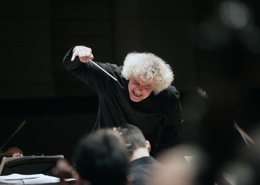“Don’t do anything correct,” he insisted. His next command was the order of business for last Thursday evening.
“Play Wagner!” exhorted Sir Simon Rattle, principal conductor of the Berlin Philharmonic.

way with Tristan und Isolde
Illustration by Jeff Dunn
You have to give me all the sound and passion possible … Join every note … There’s no such thing as a single note in this piece … It’s not dark enough … It’s not deep enough … They take five hours to die … Now shock the hell out of us! … You’re playing exactly what it says, but nothing that it means.Make it a whole lot more caloric … More threatening — and make it dark! … I have to understand what you feel about this! … It should never be like this building; it should be like waves … There are pebbles in the water — I want the ripples, but not the pebbles … Every single person has to play something transcendent … It’s a soup of quivering long notes … In Wagner, not sweet, but SWEET!
You are in your 20s — is this all the sound you are going to give me for the end of the world? … Use your whole body — you cannot sit there like lumps … How about a nuclear explosion? Think of North Korea.
Negotiating the Hairpins

The result was electric among the musicians. “This was the best I’ve heard the orchestra play in two years,” declared one violinist. Another declared it was the highlight of his life. Flutist Calisa Hildebrand felt she reached new levels of excellence:
I thought it was amazing because he was demanding that we reach the potential that I feel like we’ve always had. And I’ve never heard the orchestra play that loud, ever. And the pizzicato: When he was working on that, the cellos were like Boom! Wow! Where did that come from? I thought, “Who are these people?” And he does it in such an inoffensive way. It’s like “That doesn’t sound good. Do it again.” I’m like “Oh, OK.” He’s polite, but also demanding, which is the perfect combination to pull something out of you.
The pulling came from the audience as well, which endured those highly sensuous musical passages over and over again. It responded with an extended and enthusiastic ovation at the conclusion of two wringing hours. For me, the repetition was worth it, for each time the music was better. When many of the musicians started using their “whole bodies” per Rattle’s suggestion, the visuals helped me imagine the truly transcendent performance — however “incorrect” the playing — that the conservatory players may experience someday in their future careers, thanks in part to what Sir Simon had so powerfully inculcated in one San Francisco evening.

